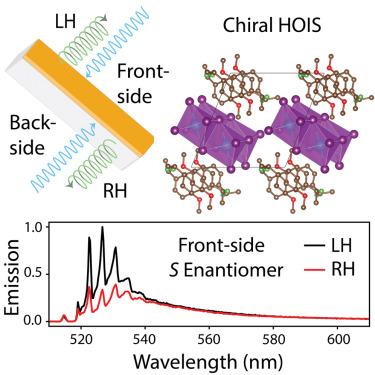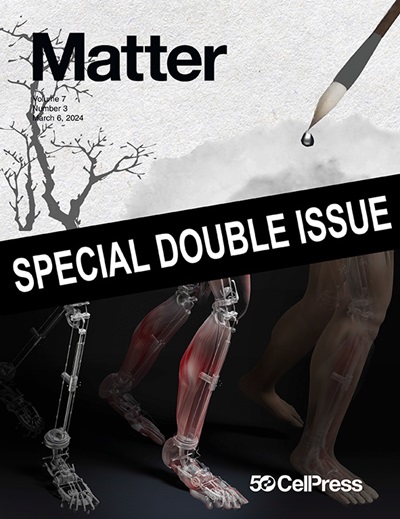Large propagation-direction-dependent circularly polarized emission and scattering anisotropies of a chiral organic-inorganic semiconductor
IF 17.5
1区 材料科学
Q1 MATERIALS SCIENCE, MULTIDISCIPLINARY
引用次数: 0
Abstract
Chiral materials are important tools for transducing circularly polarized light within many emerging opto-electronic and spin-based technologies. Here, we demonstrate that thin films of a bismuth iodide-based 0D chiral hybrid organic-inorganic semiconductor (HOIS) exhibit large anisotropy values in circularly polarized light emission (CPLE) that approach 50%, with mirror-image responses from front- and back-side measurements. A comprehensive analysis of light-wave propagation, absorption, emission, and scattering is constructed on the basis of a symmetry-derived exciton fine structure model, which accurately describes the direction and polarization dependence of the observed excitonic circular dichroism and CPLE, including contributions from both photoluminescence and resonant Raman scattering. Our analysis indicates that molecular chirality drives preferential film alignment with respect to the out-of-plane lattice vector direction, producing the observed anisotropies. This first demonstration in an HOIS system provides a unique route for enhancing polarization-dependent emission, and circularly polarized light transduction more broadly, in self-assembled HOIS.


手性有机-无机半导体的大传播方向相关圆偏振发射和散射各向异性
在许多新兴的光电和自旋技术中,手性材料是圆偏振光转导的重要工具。在这里,我们证明了基于碘化铋的0D手性杂化有机无机半导体(HOIS)薄膜在圆偏振光发射(CPLE)中表现出接近50%的大各向异性值,具有正面和背面测量的镜像响应。基于对称导出的激子精细结构模型,对光波的传播、吸收、发射和散射进行了综合分析,该模型准确地描述了观测到的激子圆二色性和CPLE的方向和偏振依赖性,包括光致发光和共振拉曼散射的贡献。我们的分析表明,分子手性驱动相对于面外晶格矢量方向的优先薄膜排列,产生观察到的各向异性。这在自组装HOIS系统中的首次演示为增强偏振相关发射和更广泛的圆偏振光转导提供了独特的途径。
本文章由计算机程序翻译,如有差异,请以英文原文为准。
求助全文
约1分钟内获得全文
求助全文
来源期刊

Matter
MATERIALS SCIENCE, MULTIDISCIPLINARY-
CiteScore
26.30
自引率
2.60%
发文量
367
期刊介绍:
Matter, a monthly journal affiliated with Cell, spans the broad field of materials science from nano to macro levels,covering fundamentals to applications. Embracing groundbreaking technologies,it includes full-length research articles,reviews, perspectives,previews, opinions, personnel stories, and general editorial content.
Matter aims to be the primary resource for researchers in academia and industry, inspiring the next generation of materials scientists.
 求助内容:
求助内容: 应助结果提醒方式:
应助结果提醒方式:


